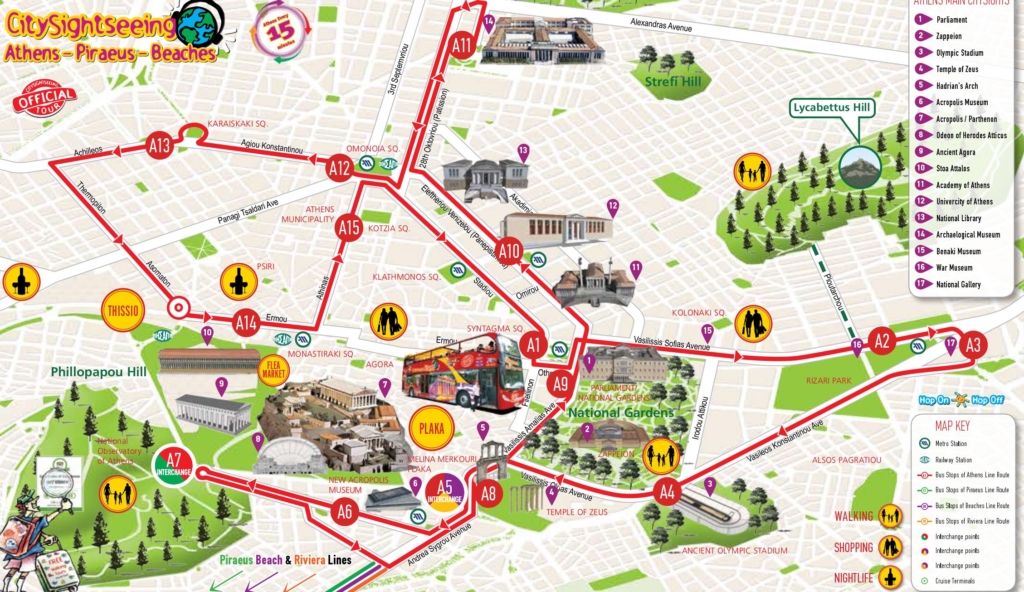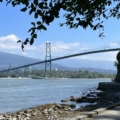Visiting Athens is rubbing shoulders with the Gods of Greek Mythology and stepping back in time to the days of Greek Antiquity and the Roman Empire. A timeless experience that can be done entirely in 4 or 5 days!
I was able to do this trip in August 2022 with 3 friends. Here is the program, which we had prepared well in advance to be able to make the most of it, as well as my tips and impressions.
The program day by day
Athens is a city of 39 km², but most of the monuments to visit are grouped together in its heart, around the Acropolis. It is therefore easy to go from one site to another on foot.
This map offered by the CitySightSeeing tourist bus service gives a very good overview of the distribution of the main sites mentioned in this article.
For the sites furthest from the centre, such as the Kerameikos archaeological site, there is a very extensive, modern and frequent public transport network (metro, tram, bus). We can thank the 2004 Athens Olympics thanks to which lines were extended and created!
The ticket to use this public transport network costs only €9 for 5 days unlimited (Please note, for the connection with the airport, you must take a specific ticket, also at €9).
I advise you to :
- schedule your visits early in the morning, or in the evening before closing time, to avoid queues and the heat.
- buy beforehand on the official website of the Greek Ministry of Culture a combined ticket of 30€ allowing access to the 6 main sites: the Acropolis, the Ancient Agora, Keramikos, Hadrian’s Library, the Roman Agora, the Olympeion and Aristotle’s Library.
Here is the 5-day program, which I detail in the rest of the article.
- Day 1 (afternoon)
- Exploration de la colline Philopappos
- Day 2
- Morning : Visit of Olympiéion (temple of Olympian Zeus), visit to the Panathenaic stadium, the Zappeion, the National Garden, the Greek Parliament (changing of the guard)
- Afternoon : Hadrian’s Library, Ancient Agora
- Day 3
- Morning : Acropole, Agora romaine
- Afternoon : National Museum of Archeology, climb of the Lycabettus hill, the hill of the Muses, and sunset over the Aeropagus
- Day 4
- Morning : Acropolis Museum
- Afternoon : Beach
- Day 5
- Visit to the archaeological site of Kerameikos (Pompeion and ancient necropolis), Athens Cathedral, Shopping on Ermou StreetHadrian’s Library, Ancient Agora
Day 1: Explore Philopappos Hill
As soon as we arrived at the airport, settled into the accommodation… heading for the center of Athens, where we had planned to climb the Philipappos hill, described in quite a few tourist guides as “the most beautiful point of view on the ‘Acropolis”.
Indeed after a few minutes, we were able to admire in its entirety the famous “Domain of the Gods of Olympus” and its temples, embellished by the light of the end of the day. There are lots of handcrafted jewelry vendors on the pedestrian road that leads up the hill, then several restaurants and shops. You will even find an open-air cinema showing recent films!
At one point, you have to turn left towards the path that leads to the Acropolis, and immediately take the path leading to the hill of Aeropagus (which is therefore a hill on the hill…). You reach it via metal stairs, and you immediately reach the top, be careful it’s rocky ground, and it’s slippery!
Areopagus
The hill of Areopagus is so named because it was, according to legendary tradition, the place where Ares was judged (and acquitted) by the other gods, after having killed Halirrhotios, son of Poseidon who had raped Alcipe (daughter of ‘Ares).
This place is often full of people, tourists and locals, to enjoy the view of the Acropolis and Athens, and watch the spectacle of the sunset bowing out behind the mountains.
Here are views of the hill itself, the view towards the Acropolis, and the view of the Ancient Agora, which sits below. I added a photo of the famous sunset that can be admired from the hill.
Day 2: from Olympiaion to the Ancient Agora
After a good night’s sleep, get up early to start the second day (first full day), where we had planned to visit several sites…
Rendezvous with Zeus at the Olypeion
We had planned to get into the thick of it quickly by going to Olympeion, otherwise known as the Temple of Olympian Zeus. You enter through Hadrian’s Gate (18-meter marble arch built in honor of Emperor Hadrian, in the 2nd century AD. It delimited the border between the ancient city of Theseus and the new Roman city) .
Olympeion or the Temple of Olympian Zeus

The Olympiaion is a sanctuary occupying the esplanade located at the crossroads of Olga and Amalia avenues in Athens. In the center stands the Temple of Olympian Zeus, the largest Corinthian temple in Greece (107.75m by 41). It is a dipterous temple (surrounded on each of its four sides by two rows of columns), in the Corinthian style, built in Pentelic marble.
The site was inhabited since prehistoric times and a cult to Zeus is certified in antiquity. The construction of the monumental temple began around 515 BC but it was never finished due to the fall of tyranny in Athens. In 174 BC, Antiochos IV Epiphanes, king of Syria, resumed the construction of the temple which was finally finished by the Roman emperor Hadrian, in 124/125. Inside the temple was a huge chryselephantine (gold and ivory) statue of Zeus.
Small disappointment: of the 15 remaining columns of the Temple of Olympian Zeus, most were under scaffolding. But these are undoubtedly restorations that will make the place even more appreciable, and a reason to return to Athens another time.
Note that there are many remains and statues all around the temple area.
The Panathenaic Stadium
Once out of the temple, we move away from the Acropolis to quickly arrive at the Panathenaic Stadium. Admission is charged and not included in the combined ticket, but just the view from the outside is enough to realize the size of the stadium and appreciate it in its entirety.
The Panathenaic Stadium
The Panathenaic Stadium is an ancient stadium, built in 330 BC to host the Great Panathenaic (festivals taking place every 4 years, with sports and artistic competitions).
A few centuries later, in 140 AD, Herod Atticus (to whom we owe the Odeon in particular) set out to rebuild the stadium entirely in white marble.
After the fall of Rome, the stadium fell into disrepair. In the Middle Ages, it served as a quarry for marble, used for other constructions.
The stadium fell into total oblivion until the 19th century, when Evangelista Zappas financed excavations to update this emblematic place in order to organize the first modern Olympic Games.
It was then rebuilt entirely in marble by the architect Ernst Ziller and above all thanks to the patronage of Georges Averoff, whose statue can be seen at the entrance to the stadium. The track was sown with grass and in 1896, the first Olympic Games of the modern era in Athens took place in this stadium.
Here are some photos taken in front of the stadium.
A little shade at the National Garden
Near the Panathenaic Stadium is the National Garden, very pleasant to walk through. This one was built in 1839-1840 by Queen Amalia, the wife of the first king of Greece, Othon 1st. We thus find this very particular style of the gardens of the XIXth century (winding paths, small ponds with bridges… and even ruins!).
We just crossed this part a bit at random and we arrived in front of the Zappeion, a magnificent neo-classical building which dates from the same period. You can enter for free and enjoy the magnificent hall (admire the ceiling…) and the atrium.
Meeting with the Evzones
Leaving the National Garden, after a short walk we arrived at Syntagma Square, where the Greek Parliament is located, in an imposing building built between 1836 and 1842 to initially serve as a palace for Othon, the first king of Greece.
Opposite the building is the Tomb of the Unknown Soldier, guarded day and night by the “Evzones”, two guards dressed in a very colorful traditional uniform, and wearing red shoes with black pompoms! It is possible to attend the changing of the guard which takes place every hour, with a very amazing choreography. I invite you to read this very comprehensive article on Evzones.
Here are some photos taken at this place, where we had the chance to arrive right for the changing of the guard.
On the other side of the Parliament is Ermou Street, one of the main shopping streets in Athens…but we had preferred to reserve the “shopping” time for the last day, just before the trip to the airport. I think that doing so allows you to stay “focused” on the cultural and historical discovery of places.
From Plaka to Hadrian's Library
We then headed to the Pláka district, highly recommended by all the tourist guides read during the preparation of the trip.
We should have prepared this part of the trip a little more because while wandering the neighborhood a bit randomly, we mostly came across streets full of souvenir shops and tourists. Chance did bring us to a delicious restaurant, on the terrace of course and with a magnificent view: La Taverne Saïta.
Here are some photos taken in the Pláka district.
After this good meal, we headed to Monastiraki Square to visit Hadrian’s Library.
Hadrian's Library
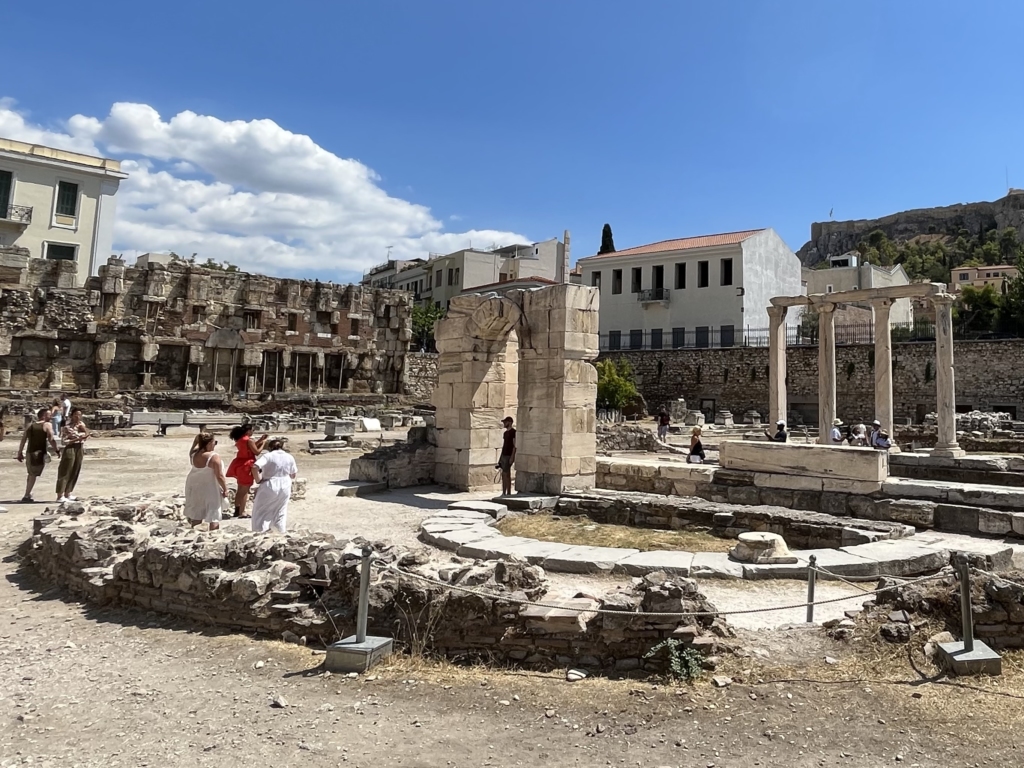
Hadrian’s Library was raised around 132 A.D. and is identified as a library, cultural center, forum, archive repository or palaestra and temple of the Imperial cult.
It owes its name to its main donor: the Philhellenic Roman emperor Hadrian.
It is devastated by a herule raid in the following century. It consisted of a peristyle courtyard of approximately 100 m by 70 m. It would have contained more than 20,000 rolls.
It is a visit that is done relatively quickly, it takes between 30 and 45 minutes, even if you carefully read all the explanatory panels.
2 hours at the Agora of Athens
After a short “iced coffee” break, we headed to an older and much larger place: the Ancient Agora of Athens! For this visit, it is necessary to allow a little more time, say 1h30, a little more if you wish to visit the Agora museum, in the Stoa of Attalos.
Ancient Agora of Athens
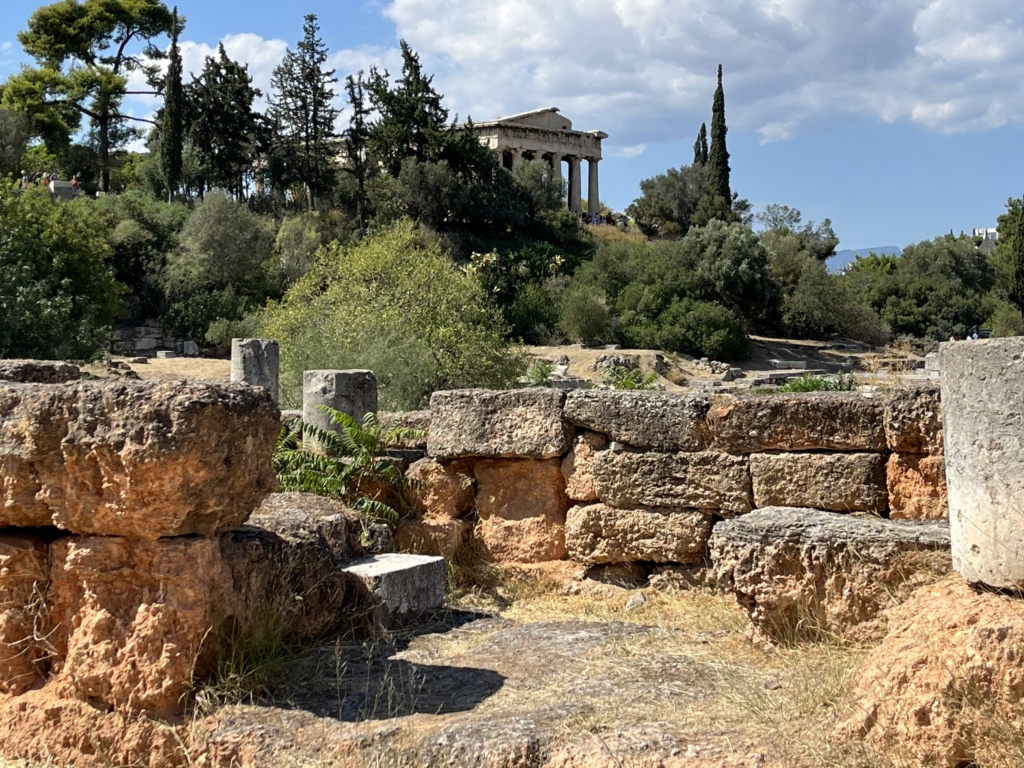
The ancient Agora, was the center of the classical city of Athens. The oldest buildings and temples date from the 6th century BC. These have enabled the development of strong administrative, political, judicial, commercial, social and religious activity in this location.
The main monuments of the site are the Stoa of Attalus, which now houses the museum of the ancient Agora, the Temple of Hephaestus (the best preserved temple in Greece), the Dome and the Chamber of the Boulefterion.
To highlight the ancient monuments had to be demolished more than 400 new buildings.
The most impressive part of this visit was for me the Temple of Hephaestus (built between 449 and 415 BC), which is in a truly impressive state of conservation (and restoration), contrasting with the ruins of the buildings that surround it and which require a lot of imagination to imagine what they looked like during Antiquity.
Day 3: the Acropolis from near and far
After this busy day … we had planned an even busier one!
Visit of the "Domain of the Gods"
For the morning of this 3rd day, we had planned to arrive early in front of the most visited site of the city: the Acropolis, to be able to visit it without spending too much time waiting.
Acropolis
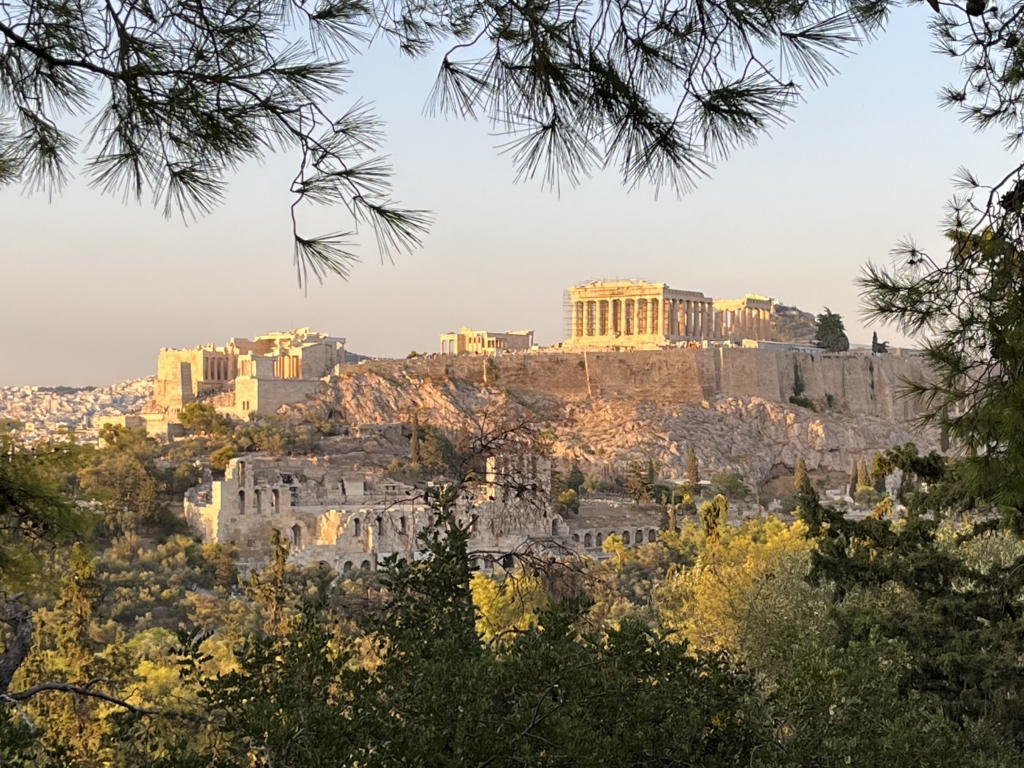
The establishment on the site of the Acropolis of Athens dates back to the 4th century BC Most of the current ruins were built during the reign of the politician Pericles. His most important contributions are the Parthenon, the Propylaea, the Erechtheion and the Temple of Athena Nike.
The temples of Athena Polias, Poseidon, Cecrops, Herse, Pandrosus and Aglaurus, with its balcony of the Caryatids, began at the same time. During the Hellenistic and Roman eras, many adjacent structures were renovated. The Parthenon was transformed into a church during the Byzantine years. The Latins used the Acropolis of Athens as the main administrative center of the city.
If you want more information, the best resource I have found on the Acropolis is the page dedicated to it on the UNESCO website.
We were able to avoid the wait, especially since we had our tickets pre-paid.
The climb to the Acropolis is very pleasant as you pass several remarkable monuments: Theater of Dionysos, Temple of Themis, Odeon of Herodes Atticus.
Arrived in front of the entrance to the Acropolis (the Propylaea), you have to be a little patient because the passage is narrow. I think that in the afternoon, the wait must be very, very long… In any case, it allows you to admire the incredible view, especially of the ancient Agora located just at the foot of the hill. We will also enjoy admiring this temple, and the small temple dedicated to Athena Nike, located on the left and visible between the huge columns of the temple / entrance.
Once arrived on the esplanade of the Acropolis, the visit is done by following the counter-clockwise direction. It’s really a timeless visit, impressive, we take our breath away in front of these marvelous temples, so well restored (and still being restored). Each temple is totally different, from the small temple of Athena Nike to the imposing Parthenon… special mention for the Erechtheion, its caryatids (statues of women acting as columns) and its sacred olive tree of the goddess Athena.
The explanations on the panels are very interesting while being concise. They are embellished with plans and illustrations.
Here are some photos taken during the visit to the Acropolis, with very hot weather but ideal for taking photos.
The other Agora: the Roman Agora
After this visit and a short break, we visited the Roman Agora.
The Roman Agora was built at the end of the 1st century BC thanks to a donation from Julius Caesar and Augustus. Formed by galleries and boutiques, it quickly brought together the commercial and economic activity of the city.
My advice: If for lack of time you have to choose only one visit between the two Agoras: choose the Ancient Agora!
The most interesting part of the Roman Agora is at the back of the site, with the Tower of the Winds.
This was built by a great Macedonian astronomer in the 1st century BC. The tower is 12 meters high and has a diameter of about 8m. Very well preserved, this tower included a hydraulic clock powered by a spring from the Acropolis hill, which was used to tell the time according to a very precise mechanism.
The Tower of the Winds also featured a solar clock (thanks to sundials located on each of its faces). Finally, the gently sloping conical roof had a pivoting weather vane at its top, the point of which pointed in the direction of the wind.
Its remarkable state of preservation comes from the fact that it was used by the Christians as a baptistery, then by the Turks as a dance hall for the Dervishes.
Museum of Archeology and Lycabettus
After this visit and a good meal, I motivated myself to discover the National Archeology Museum and Lycabettus Hill. My friends preferred to take a nap, I can understand them! I hesitated but I wanted to take full advantage even if it meant ending the day exhausted. Plus I had a blog post to fill out 🙂
So I walked through totally deserted neighborhoods, with condemned shops, tagged facades, like everywhere in Athens as soon as you move away from the tourist locations. At a certain place there was a huge police and military presence, I asked a soldier the reason for this presence, he replied that it was usual here, and “Welcome to Greece”.
Intrigued, I talked about it to a friend living in Athens, who told me that this strong presence was to prevent any beginning of protest movement against the power in place.
So I arrived in front of the National Archeology Museum which I visited with great interest. It really is one of the most impressive museums I have visited. It brings together objects and statues from all over Greece, and presented in chronological order. We start with the Neolithic era, then we arrive in ancient Greece, to end on the time of the Roman Empire.
It is undoubtedly the statues of the gods Zeus and Poseidon, and the giant statues of Kouros (Wikipedia explanations here) that impressed me the most.
Here are some photos taken in this magnificent museum.
I then continued my solitary journey to Lycabettus Hill. Arrived at the foot of the hill, not having found where the funicular was, I climbed it on foot, in the company of two tourists from Lyon! There were really not many of us, in fact only the three of us, making the climb at that time. You must have good legs because the climb is quite steep. It is possible to take a short break in a restaurant located about 3/4 of the way up, with a magnificent terrace allowing you to admire the city and the Acropolis located opposite and at about the same height.
Going up a bit more, you get to the top of the hill, and you get the full measure of its pointy appearance (when you see the hill from a distance), because the top is really tiny. There is just room for a small church, a tower, a flag, a small plaza, and some sort of viewing balcony. We suddenly have a totally incredible 360 degree view, certainly the most beautiful view of Athens.
So it is REALLY worth going to Lycabettus hill, which for me is the equivalent of Tibidabo hill in Barcelona. This has to be the place in Athens where you have the best view of the whole city.
If the church is open, do not hesitate to visit it, it is very fast because it is tiny!
In the school of Aristotle
On leaving, I passed by the rue des embassies, where there is notably the army museum, and a little further on Lykeon (the philosophical school of Aristotle).
Unfortunately, there is not much left except for the foundations and some vestiges of walls. Two very complete explanation panels facilitate the work of imagination necessary to appreciate the place.
Unlike other sites, there are quite a few benches in the shade of trees, so it’s a calm and pleasant place that allows you to breathe, relax…
I then headed to the Philopappos hill, where I had an appointment with my friends to admire the sunset from the Aeropagus.
Before that, I went all the way to the top of the hill, where the Monument of Philopappos is. This place has a magnificent view of both the Aegean Sea and the Acropolis.
Here are some photos taken there.
Day 4: Acropolis Museum and Beach
We started this fourth day with the visit of the new museum of the Acropolis.
This museum was inaugurated on June 20, 2009. You cannot miss it, it is located at the foot of the Acropolis, opposite the ticket office / entrance to it.
The ticket is not included in the “combined” ticket allowing access to the Acropolis in particular. Again in order to save time, we advise you to buy your tickets online before the visit. Beware of advertising links, the official ticket office is here: https://etickets.theacropolismuseum.gr/?culture=en.
The price for admission is 10 € full price, and 5 € reduced price.
When you arrive in front of the museum, you are struck by the contrast between the ultra-modern appearance of the building (steel and glass), and the archaeological remains that surround it and over which you have to pass to enter the building.
The visit to the Acropolis Museum is really to be done in addition to the visit to the Acropolis, because:
This allows you to have explanations on the origin of the place, its evolution over time, thanks in particular to models and videos.
There are magnificent objects and statues found during excavations at various times.
These statues are presented in “forest” mode and not behind windows, it is very significant. The place reminded me of the Louvre Lens museum (time gallery), built around the same time
There are various areas dedicated to each temple (ex: the Athena Nikè temple), so it allows you to make a thematic visit
The top floor reproduces in its dimensions and configuration the upper part of the Parthenon, there are remains of the two pediments, and side friezes. There is not much left of the statues of the pediments but miniature reproductions of these allow you to realize their initial appearance.
One of the most impressive areas of the museum is for me the one hosting the Caryatids, these statues of women who supported the Erechtaion (sanctuary built on the most sacred part of the Acropolis).
These are the real statues that are exhibited here, indeed those that we see today on the Acropolis are reproductions.
The sixth caryatid is in the British Museum in London, along with a large part of the Parthenon friezes.
An agreement was reached in June 2022 for this statue and the Parthenon marbles to be “shared” between the two countries: more information in this Geo article.
An interesting video shows on the spot how these statues were restored, thanks to modern technologies, in particular laser.
Here are some photos taken in the museum.
After this memorable cultural visit, and another very good, inexpensive meal on the terrace, we headed to … the page!
We opted for the first beach accessible by metro – tram: Paralia Edem.
Nothing to say about this beach: very clean, toilets and showers, possibility to eat on site… and of course a magnificent view. Unlike some beaches, especially in Crete, it’s a sandy beach so there’s no risk of opening your feet when going for a swim, it’s nice.
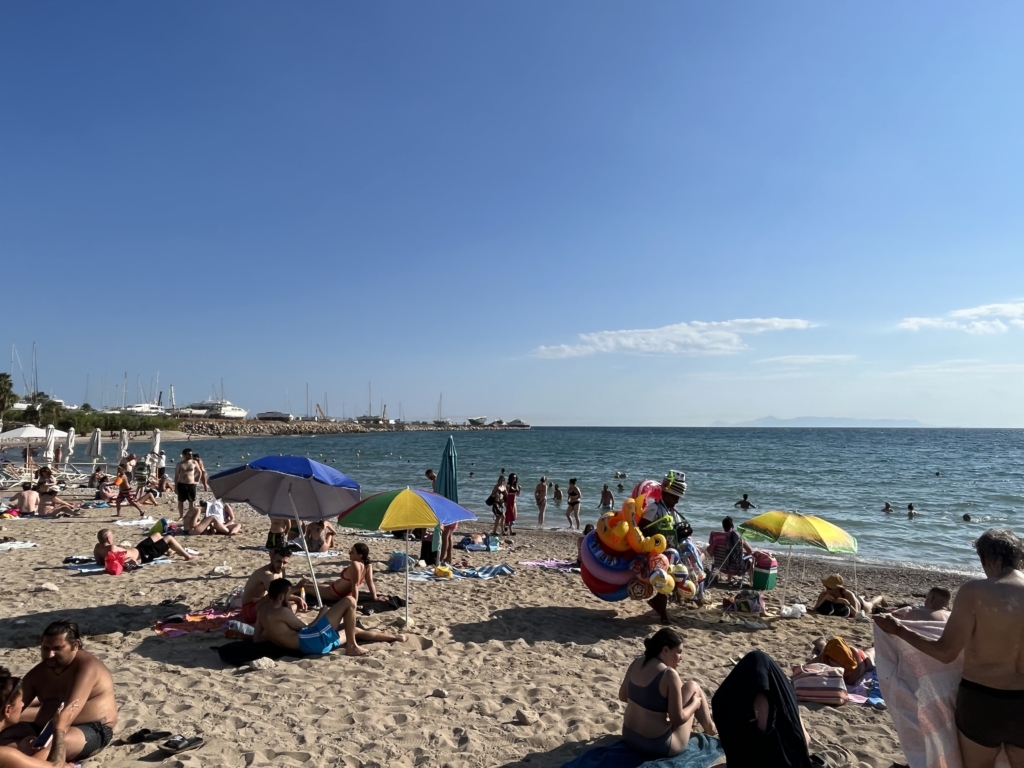
Day 5 : Kerameikos and Athens Cathedral
For the last day (very hot), we still had to visit Kerameikos, the last site included in the combined ticket.
Kerameikos
Le site archéologique de Kerameikos à Athènes se situe entre l’Agora antique et Technopolis.
Kerameikos comprend une vaste zone à la fois à l’intérieur et à l’extérieur des anciens murs de la ville, des deux côtés de la porte Dipylon et par les rives de la rivière Eridanos. C’était le quartier des potiers de la ville, d’où vient le mot anglais “céramique”.
On distingue deux zones, de chaque côté de l’ancienne muraille :
- Pompeion, bâtiment dans lequel on gardait tous les ustensiles sacrés dont on faisait usage pour les différentes fêtes (notamment les panathénées). De nombreux vestiges de bâtiments plus petits que Pompeion sont accessibles et bien explicités par des panneaux.
- L’ancienne nécropole, déjà présente à cet endroit au XIIe siècle avant J.C. De nombreuses sculptures funéraires sont érigées le long de la Voie Sacrée, une route reliant Athènes à Eleusis.
It was a less demanding visit than that of the Acropolis and the agoras, but quite interesting, both for the remains of the Pompeion and for the ancient necropolis.
Note that there is a museum near the archaeological site, but overwhelmed by the heat we did not bother to look for it.
Here are some photos taken at the archaeological site of Kerameikos.
It was a less demanding visit than that of the Acropolis and the agoras, but quite interesting, both for the remains of the Pompeion and for the ancient necropolis.
Note that there is a museum near the archaeological site, but overwhelmed by the heat we did not bother to look for it.
Here are some photos taken at the archaeological site of Kerameikos.
My impressions of the city
Juste au moment de quitter Athènes, j’avais pris le temps de noter mes impressions “à chaud”, les voici :
- Aucun quartier ne se ressemble chacun a son identité (Plaka, Syntagma, Gazi …)
- Transports très modernes et propres, bonne fréquence, toute la ville est couverte via le réseau de métro – tram … même les plages ! merci les Jeux Olympiques de 2004
- Dans les quartiers non touristiques on est marqué par les maisons et commerces à l’abandon total couvertes de (souvent très beaux) graffitis, les trottoirs défoncés et l’absence de marquage au sol. Cela est lié à la grande crise économique du pays de 2008. Le pays commençait à s’en remettre quand le COVID-19 est arrivé. On m’a également expliqué que les loyers ont tellement augmenté à la fois pour les habitations que pour les commerces, que beaucoup ont choisir de partir dans les “suburbs” (banlieue).
- C’est une ville de Street Art ! Certaines façades sont entièrement couvertes d’oeuvres géantes et magnifiques
- Énorme présence policière et militaires dans certains quartiers (ex : 50 policiers / soldats en statique autour d’une place)… apparemment c’est pour éviter et empêcher toute contestation du pouvoir en place, mouvements anti-pouvoir (d’après un habitant )
- Comparé à d’autres villes, Athènes est très peu chère ! Il est possible de faire d’excellent repas typiques pour pas cher, même dans des restaurants avec terrasse vue sur l’Acropole (ex : délicieuse Mousaka pour 9€, salade grecque à 7€ …). Idem pour les produits « touristiques », qui restent abordables. Mention particulière pour les petites statues en bronze qu’on retrouve un peu partout !
- Quelques surprises au restaurant : on a l’addition avant d’avoir les plats, dans certains restos en plus des plats on paie les couverts (1€) et le pain mis à table même si on y touche pas. Ca compense le faible prix des plats
- Il est possible de trouver des logements vraiment peu onéreux : Nous avions un grand logement équipé pouvant accueillir 4 personnes avec terrasse immense pour 50€/nuit à 20 min du centre en métro … certes pas le plus beau quartier
- Beaucoup de points d’eau pour remplir sa gourde, on n’incite pas à acheter des boissons … tant mieux vue la chaleur
- Les grecs sont pour la plupart parfaitement bilingues (anglais) donc aucun soucis de communications que ce soit avec les commerçants et locaux. Niveau sympathie des commerçants : c’est tout ou rien !


